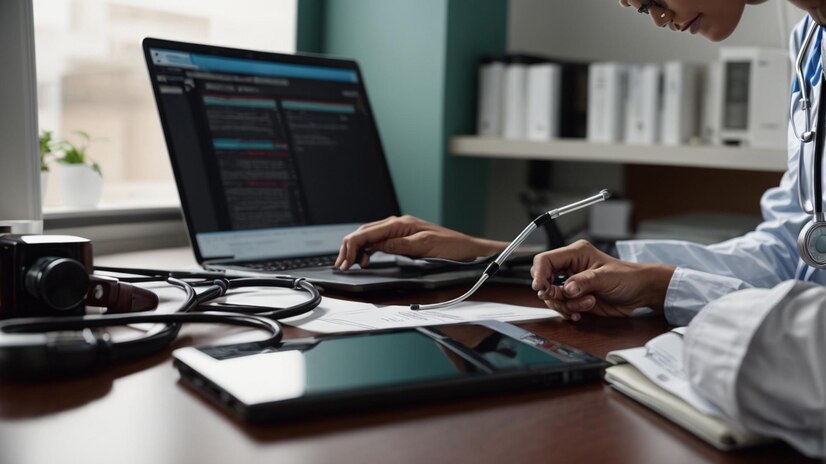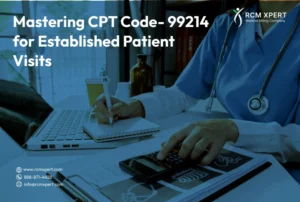In today’s fast-paced healthcare environment, understanding urgent care billing and coding is critical for operational success and financial stability. Guidelines explain the complexities of billing and coding processes, providing urgent care professionals with the knowledge needed to handle reimbursement problems effectively.
This information will help to manage and better understand the field of medical coding, urgent care, or health policy expertise, to enhance billing practices, ensuring accuracy, compliance, and optimized revenue cycles in the dynamic world of urgent care.
Exploring CPT Codes for Urgent Care Visits
Exploring CPT Codes for Urgent Care Visits the variations of Urgent Care Billing and Coding Guidelines, ensuring professionals with the deep knowledge to understand the complexities of billing for diverse urgent care services efficiently.
Key CPT Codes for Common Urgent Care Services
Here’s a detailed table covering “Key CPT Codes for Common Urgent Care Services,” which includes the code, the service it corresponds to, and a brief description. This format will help in understanding the specific services that each code represents.
| CPT Code | Service Description | Brief Description |
| 99201-99205 | Evaluation & Management (E/M) for New Patients | Varies from minimal to comprehensive evaluation based on complexity and time spent. |
| 99211-99215 | E/M for Established Patients | Ranges from a brief check-up to a detailed examination, depending on patient history and visit complexity. |
| 10060-10061 | Incision and Drainage of Abscess | Simple or complicated procedures for abscess treatment. |
| 10120-10121 | Removal of Foreign Body | Removal from subcutaneous tissues or from muscle and/or tendon. |
| 12001-13160 | Wound Repair (Simple, Intermediate, Complex) | Codes vary by wound size and complexity, including sutures. |
| 29125-29131 | Application of Splints (Extremities) | Application includes forearm, wrist, hand, finger(s), knee, and leg splints. |
| 99281-99285 | Emergency Department Visits | Categorized by the complexity of the visit, ranging from minor to high-severity problems requiring immediate intervention. |
| S9083 | Global Fee for Urgent Care Services | A fixed rate for all services provided during a single visit (not accepted by all payers). |
| S9088 | Urgent Care Facility Visit Fee | Additional code for services provided in an urgent care setting (used alongside appropriate E/M codes). |
Updates and Changes to CPT Codes in 2024
Here’s a table that outlines the anticipated updates and changes to CPT codes in 2024, focusing on those likely to impact urgent care services. The specifics of these updates are based on general expectations for the kind of changes that occur annually and should be verified with the latest AMA releases for accuracy.
| CPT Code | Change Type | Description of Change | Impact on Urgent Care |
| TBD | New | Introduction of new codes for emerging technologies and procedures. | Enables billing for newer services and technologies adopted in urgent care. |
| TBD | Revision | Updates to descriptions and guidelines for existing codes to reflect current medical practice. | Clarifies billing practices and potentially expands the applicability of certain codes. |
| TBD | Deletion | Removal of outdated or rarely used codes. | Requires adjustment in billing practices for services previously covered by these codes. |
| TBD | Addition | Addition of new modifiers to specify nuances in services provided. | Improves the specificity of billing, potentially affecting reimbursement rates. |
Decoding CPT Codes for Urgent Care: A Comprehensive Overview
Understanding the complex world of CPT codes is crucial for accurate billing in urgent care settings. This section explores the essentials of CPT codes, providing a foundational understanding important for “Urgent Care Billing and Coding Guidelines
Common CPT Codes Used in Urgent Care Settings
| CPT Code | Description | Application in Urgent Care |
| 99201-99205 | Evaluation and Management (E&M) of New Patients | Used for initial patient evaluations based on the complexity of the visit |
| 99211-99215 | E&M of Established Patients | Applied for follow-up visits or ongoing care of known patients |
| 12001-13160 | Wound Repair (Simple, Intermediate, Complex) | Includes suturing of minor cuts, lacerations, or wound closures |
| 10060-10180 | Incision and Drainage of Abscess | For treatments involving abscess drainage or similar procedures |
| 20550-20553 | Injections of Tendons, Ligaments, Ganglion Cysts | Utilized for therapeutic injections for pain relief or inflammation reduction |
| 29000-29799 | Application of Casts and Splints | Pertains to the application of casts or splints for fractures or injuries |
| S9083 | Global Fee for Urgent Care Services | Covers a comprehensive charge for services provided during a visit |
| S9088 | Urgent Care Visit (in conjunction with an E&M code) | Specific to urgent care centers for enhanced reimbursement |
Best Practices for Applying CPT Codes in Urgent Care Billing
To maximize reimbursement and minimize denials, urgent care centers should follow best practices in applying CPT codes. This includes thorough documentation to support the chosen codes, regular training for staff on the latest coding guidelines, and using auditing tools to identify and correct coding errors before claims submission.
Understanding Urgent Care Billing Guidelines: Key Principles and Practices
Urgent Care Billing and Coding Guidelines, focusing on the foundational principles and best practices essential for accurate and efficient billing in urgent care settings.
Essential Elements of Urgent Care Billing and Coding
Some of the essential elements of urgent care billing and coding are as follows:
Accurate Patient Information: The foundation of effective billing starts with the accurate collection of patient information, including personal details, insurance coverage, and verification. This step is critical to ensure claims are correctly directed and processed by payers.
Thorough Documentation: Clinical documentation must be comprehensive, capturing the reason for the visit, the services provided, any procedures performed, and the outcomes. This documentation supports the billing codes used and is essential for justifying claims to insurance companies.
Correct Coding: Utilizing the right Current Procedural Terminology (CPT) codes, International Classification of Diseases (ICD-10) codes, and Healthcare Common Procedure Coding System (HCPCS) codes is essential. These codes communicate the services provided to the insurance companies. Correct coding reduces the risk of claim denials due to errors or discrepancies.
Use of Modifiers: Modifiers are used in medical coding to indicate any alterations or specific circumstances related to a service provided but not changed in its definition or code. Knowing when and how to use modifiers correctly is crucial in urgent care billing to ensure accurate reimbursement.
Knowledge of Payer Policies: Understanding the various insurance payer policies, including Medicare, Medicaid, and private insurers, is crucial. This knowledge helps in submitting claims that align with each payer’s requirements, minimizing denials and delays.
Common Mistakes in Urgent Care Billing and How to Avoid Them
Here are the most common mistakes in urgent care billing and strategies to avoid them:
Incorrect Patient Information: Simple errors in patient data, such as misspelled names or wrong insurance ID numbers, can lead to claim denials.
Avoidance Strategy: Implement a double-check system for all patient information at check-in and before claim submission.
Inadequate Documentation: Failure to document the visit comprehensively can result in claims being denied for lack of medical necessity or insufficient detail.
Avoidance Strategy: Train clinical staff on the importance of detailed documentation that supports the billing codes used. Regularly review documentation practices to ensure they meet payer requirements.
Misuse of Codes: Incorrect or outdated CPT, ICD-10, and HCPCS codes can lead to denied or underpaid claims.
Avoidance Strategy: Regularly update coding resources and provide ongoing education for coding staff. Utilize coding validation tools within billing software to catch common coding errors before submission.
Not Verifying Insurance Coverage: Assuming a patient’s insurance coverage without verification can result in denied claims if the coverage has lapsed or does not cover the services provided.
Avoidance Strategy: Make insurance verification a mandatory part of the patient check-in process.
Ignoring Denied Claims: Not addressing denied claims promptly leaves money on the table and can signal issues in the billing process that need correction.
Avoidance Strategy: Develop a systematic approach to managing denials, including analyzing reasons for denials, correcting and resubmitting claims promptly, and identifying trends to prevent future denials.
Urgent Care Coding Cheat Sheet
Creating a comprehensive “Urgent Care Coding Cheat Sheet” requires focusing on the most commonly used codes and guidelines in urgent care settings. Here’s a simplified version for quick reference:
| Category | Code Range/Specific Codes | Description/Notes |
| Evaluation and Management (E&M) | 99201-99215 | Office or other outpatient visits |
| Procedure Codes | 10000-69990 | Ranges for various procedures like laceration repair (12001-12018), incision and drainage (10060-10061), etc. |
| Radiology Services | 70010-79999 | Includes X-rays, MRI, CT scans; use specific codes for each part of the body examined |
| Laboratory and Pathology | 80047-89398 | Blood tests, urinalysis, cultures, etc. |
| Immunizations | 90471-90474 | Administration of vaccines; code per vaccine administered |
| Injections | J codes | Medication injections, including antibiotics, steroids, etc |
| Modifiers | -25, -59, etc. | -25 for a significant, separately identifiable E&M service; -59 for distinct procedural services |
| ICD-10 for Common Urgent Care Diagnoses | Varies | Examples: J06.9 (Acute upper respiratory infection), S93.4 (Sprain of the ankle) |
| COVID-19 Related Codes | U07.1, 86328, 87635 | Diagnosis and testing codes related to COVID-19 |
| Telehealth Services | 99201-99215 with modifier -95 | For services rendered via telehealth |
FAQ
How do you code urgent care visits?
To code urgent care visits, accurately determine the level of Evaluation and Management (E&M) services, apply specific procedure and diagnostic codes, and use modifiers as necessary. Documentation must support the services provided, and coding practices should align with payer guidelines.
Which code is assigned to an urgent care?
The specific code assigned to an urgent care visit depends on the level of Evaluation and Management (E&M) services, ranging from 99201 to 99215 for outpatient visits, along with additional procedure, diagnostic, and modifier codes as applicable.
What modifier is used for urgent care?
In urgent care coding, several modifiers may be used, with modifier -25 (Significant, Separately Identifiable Evaluation and Management Service) being common for indicating a distinct E&M service on the same day as a procedure. Modifier -59 (Distinct Procedural Service) is also frequently utilized to denote procedures that are separate from other services provided.














